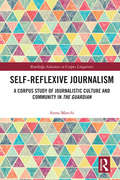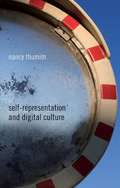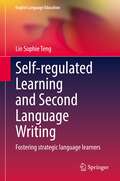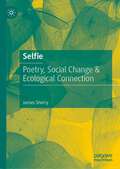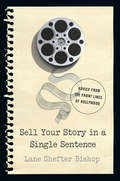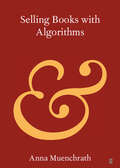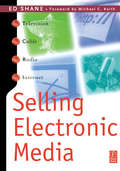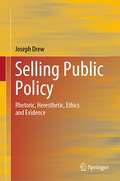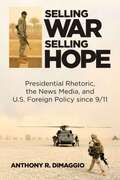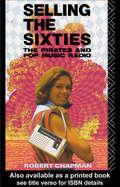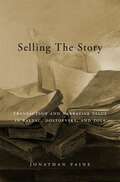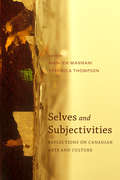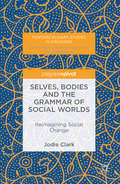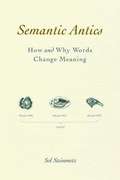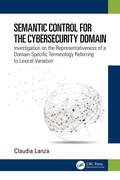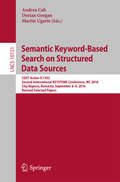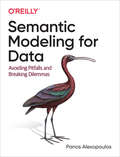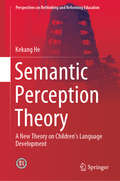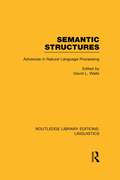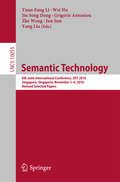- Table View
- List View
Self-Reflexive Journalism: A Corpus Study of Journalistic Culture and Community in the Guardian (Routledge Advances in Corpus Linguistics)
by Anna MarchiThis book develops a corpus-assisted approach to the study of self-reflexivity in journalism and examines the ways in which news workers and subsequently, news organizations, choose to promote an identity for themselves and the ideologies that accompany them. Using The Guardian as a case study, the volume draws on its Corpus Assisted Discourse Studies (CADS) to explore ways in which a newspaper can reflect upon itself, including how newspapers conceptualize the role of the media, how they define good vs. bad journalism, what they see as professional values, how they attempt to cement community membership amongst their readers, how they construct and project their overall identity and role as newspapers and also how they see their position within the larger community. A chapter on the book’s methodological framework reflects on critical aspects of CADS, including triangulation, objectivity and subjectivity, total accountability, and replicability. CADS methods are applied in the analysis chapters, with accompanying reflections on what we learn about the strengths and also maybe about some of the limitations of corpus methodology. A summarizing chapter ties these strands together to make the case for a CADS approach to journalism and media studies and look to the future at how the digital age has shaped the journalism landscape. With its focus in extending a CADS approach to other aspects of journalism scholarship, this volume is key reading for graduate students and researchers in corpus linguistics, discourse analysis, media studies, and journalism studies.
Self-Representation and Digital Culture
by Nancy ThumimTaking a close look at ordinary people 'telling their own story', Thumim explores self-representations in contemporary digital culture in settings as diverse as reality TV, online storytelling, and oral histories displayed in museums. Now available in paperback, Self-Representation and Digital Culture addresses the institutional contexts of production, technology and form of the texts, and the point of view of those who represent themselves. This highly original research examines how contradictory and widely different politics inform and shape examples of 'speaking for oneself'. In the book, Thumim argues that analysis and theorization of the activity of self-representation is vital for media, communication and cultural studies at a time when examples, of what should now be understood as a genre, both surround us and appear, at first glance, to all be alike.
Self-regulated Learning and Second Language Writing: Fostering strategic language learners (English Language Education #26)
by Lin Sophie TengThis monograph is to investigate practical applications and contributions of self-regulated learning (SRL) to second/foreign language (L2) writing from sociocognitive and sociocultural perspectives. It showcases a comprehensive and updated review of conceptual and methodological issues of SRL and the state-of-the-art research on its applications to L2 learning and teaching. This volume further elaborates the design and results of a large-scale project which conducts observational and intervention studies investigating SRL strategies in L2 writing. This book reveals that a cross-disciplinary understanding of SRL strategies plays a crucial role in advancing theoretical functions of SRL and in extending its applications to L2 education in general, and L2 writing in particular. This book makes significant contributions to developing and validating new conceptual frameworks and tools for evaluating multidimensional structures of SRL strategies and self-efficacy in L2 writing; elucidating the interplay of personal, behavioral, environmental and psychological factors with SRL strategies and writing performance; and presenting an effective self-regulation instructional model for nurturing L2 learners’ motivation and confidence to strategize, reflect and succeed in writing.Teng has established herself as one of the prominent scholars in the discussion of self-regulated learning strategies. Her contribution to the fields of L2 writing and strategic learning are undeniable. This monograph is an excellent showing of how her endeavors to bring established theories from educational psychology to applied writing research have progressed over a number of methodologically rigorous studies. It should be required reading for anyone with an interest in cultivating strategic writers not only in the Chinese context but worldwide. Nathan Thomas, UCL Institute of Education
Selfie: Poetry, Social Change & Ecological Connection
by James SherrySelfie: Poetry, Social Change & Ecological Connection presents the first general theory that links poetry in environmental thought to poetry as an environment. James Sherry accomplishes this task with a network model of connectivity that scales from the individual to social to environmental practices. Selfie demonstrates how parts of speech, metaphor, and syntax extend bidirectionally from the writer to the world and from the writer inward to identities that promote sustainable practices. Selfie shows how connections in the biosphere scale up from operating within the body, to social structures, to the networks that science has identified for all life. The book urges readers to construct plural identifications rather than essential claims of identity in support of environmental diversity.
Sell Your Book Like Wildfire: The Writer's Guide to Marketing & Publicity
by Rob EagarPromote and Sell Your Work! You've written a book, but if it doesn't sell, what's the point? InSell Your Book Like Wildfire, marketing expert Rob Eagar explains how to use the best promotional methods available to get your book noticed and drive sales. You'll learn how to: Increase your book sales by driving readers to bookstores and online retailers Build a brand that makes your books stand out from the crowd Secure more media interviews and speaking engagements Connect with key influencers who spread word of mouth Create raving fans who buzz about your book on social media Ignite your confidence to sell more books and make more money as an author. Whether you're a first-timer or an old-hand, self-published or traditionally published, a novelist or non-fiction writer, this is the only marketing guide you'll ever need.
Sell Your Story in A Single Sentence: Advice from the Front Lines of Hollywood
by Lane Shefter BishopEvery writing project has one thing in common--they all start with a single sentence. Writers constantly struggle to answer this question: What is your story about? Finally, a guide by a leading Hollywood insider who actually knows the answer--and now she shows you how to do it yourself! Lane Shefter Bishop, CEO of Vast Entertainment, explains the key to selling your screenplay, novel, or script. This comprehensive guide to opening career doors is the first of its kind, highlighting the tips and techniques for making your story stand out. From tips on character development to hints on points to avoid, Bishop covers all your bases when selling your story.
Selling Antislavery: Abolition and Mass Media in Antebellum America (Material Texts)
by Teresa A. GodduA richly illustrated history of the American Anti-Slavery Society and its print, material, and visual artifactsBeginning with its establishment in the early 1830s, the American Anti-Slavery Society (AASS) recognized the need to reach and consolidate a diverse and increasingly segmented audience. To do so, it produced a wide array of print, material, and visual media: almanacs and slave narratives, pincushions and gift books, broadsides and panoramas. Building on the distinctive practices of British antislavery and evangelical reform movements, the AASS utilized innovative business strategies to market its productions and developed a centralized distribution system to circulate them widely. In Selling Antislavery, Teresa A. Goddu shows how the AASS operated at the forefront of a new culture industry and, by framing its media as cultural commodities, made antislavery sentiments an integral part of an emerging middle-class identity. She contends that, although the AASS's dominance waned after 1840 as the organization splintered, it nevertheless created one of the first national mass markets.Goddu maps this extensive media culture, focusing in particular on the material produced by AASS in the decade of the 1830s. She considers how the dissemination of its texts, objects, and tactics was facilitated by the quasi-corporate and centralized character of the organization during this period and demonstrates how its institutional presence remained important to the progress of the larger movement. Exploring antislavery's vast archive and explicating its messages, she emphasizes both the discursive and material aspects of antislavery's appeal, providing a richly textured history of the movement through its artifacts and the modes of circulation it put into place.Featuring more than seventy-five illustrations, Selling Antislavery offers a thorough case study of the role of reform movements in the rise of mass media and argues for abolition's central importance to the shaping of antebellum middle-class culture.
Selling Books with Algorithms (Elements in Publishing and Book Culture)
by Anna MuenchrathIn 1997 Amazon started as a small online bookseller. It is now the largest bookseller in the US and one of the largest companies in the world, due, in part, to its implementation of algorithms and access to user data. This Element explains how these algorithms work, and specifically how they recommend books and make them visible to readers. It argues that framing algorithms as felicitous or infelicitous allows us to reconsider the imagined authority of an algorithm's recommendation as a culturally situated performance. It also explores the material effects of bookselling algorithms on the forms of labor of the bookstore. The Element ends by considering future directions for research, arguing that the bookselling industry would benefit from an investment in algorithmic literacy.
Selling Electronic Media
by Ed Shane"Selling is identifying and satisfying customer needs profitably. Profitable for you, profitable for them."Diane Sutter, President and CEO of Shooting Star Broadcasting , owner of KTAB-TV, Abilene, TexasThis is the definition of sales used throughout Ed Shane's comprehensive and timely textbook Selling Electronic Media. This new definition reflects the customer-orientation of today's marketing environment as well as the product-orientation of selling. Today's selling is a win/win proposition, a win for the seller and a win for the customer.Using interviews with industry leaders and reports of their selling experiences, Selling Electronic Media shares insight and practical advice in the basics of selling: · prospecting· qualifying· needs analysis· presentations· answering objections· closing· relationship management Focusing on the merging and converging of electronic media and the need for branding of media at all levels, this highly readable book offers complete coverage of advertising sales for radio, television and cable, plus the new and emerging mass communication technologies, primarily those generated by the Internet.Selling Electronic Media is enhanced with review highlights and discussion points and illustrated throughout with visuals used by media outlets to market commercials and their audience reach.Students pursuing sales and marketing careers in electronic media and professionals wishing to reinforce their understanding of the merging and converging media environment will find what they need in the pages of this book.
Selling Public Policy: Rhetoric, Heresthetic, Ethics and Evidence
by Joseph DrewProfessor Drew’s latest work makes the case that even great public policy needs to be deliberately and strategically sold in order for it to ultimately be considered a success. However, it seems that most people charged with the task of selling public policy simply do not have the requisite skills to do so.Selling public policy is an art that draws on disparate strands of scholarship spanning the political sciences, economics, sociology, ethics and the classics. To perform the art of selling public policy one must first master the lessons from the greats in the field. Following this, it is necessary to learn how to apply the knowledge to real-world complex scenarios in such a way that the policy is indeed sold and stays sold over the implied returns period.This book is unique in the corpus of scholarly literature because it provides both the knowledge and real-world case studies required for students, scholars, and policy practitioners to master the art of selling public policy.
Selling Shakespeare
by Adam G. HooksSelling Shakespeare tells a story of Shakespeare's life and career in print, a story centered on the people who created, bought, and sold books in the early modern period. The interests and investments of publishers and booksellers have defined our ideas of what is 'Shakespearean', and attending to their interests demonstrates how one version of Shakespearean authorship surpassed the rest. In this book, Adam G. Hooks identifies and examines four pivotal episodes in Shakespeare's life in print: the debut of his narrative poems, the appearance of a series of best-selling plays, the publication of collected editions of his works, and the cataloguing of those works. Hooks also offers a new kind of biographical investigation and historicist criticism, one based not on external life documents, nor on the texts of Shakespeare's works, but on the books that were printed, published, sold, circulated, collected, and catalogued under his name.
Selling War, Selling Hope: Presidential Rhetoric, The News Media, And U. S. Foreign Policy Since 9/11
by Anthony R. DiMaggioDetails how presidents utilize mass media to justify foreign policy objectives in the aftermath of 9/11.
Selling the Sixties: The Pirates and Pop Music Radio
by Robert ChapmanWas it a non-stop psychedelic party or was there more to pirate radio in the sixties than hedonism and hip radicalism? From Kenny Everett's sacking to John Peel's legendary `Perfumed Garden' show, to the influence of the multi-national ad agencies, and the eventual assimilationof aspects of unofficial pop radio into Radio One, Selling the Sixties examines the boom of private broadcasting in Britain. Using two contrasting models of pop piracy, Radios Caroline and London, Robert Chapman sets pirate radio in its social and cultural context. In doing so he challenges the myths surrounding its maverick `Kings Road' image, separating populist consumerism from the economic and political machinations which were the flipside of the pirate phenomenon. Selling the Sixties includes previously unseen evidence from the pirates' archives, revealing interviews and an unrivalled selection of rare audio materials.
Selling the Story: Transaction and Narrative Value in Balzac, Dostoevsky, and Zola
by Jonathan PaineEvery writer is a player in the marketplace for literature. Jonathan Paine locates the economics ingrained within the stories themselves, showing how the business of literature affects even storytelling devices such as genre, plot, and repetition. In this new model of criticism, the text is a record of its author’s sales pitch.
Selves and Subjectivities: Reflections on Canadian Arts and Culture
by Manijeh Mannani Veronica ThompsonLong a topic of intricate political and social debate, Canadian identity has come to be understood as fragmented, amorphous, and unstable, a multifaceted and contested space only tenuously linked to traditional concepts of the nation. As Canadians, we are endlessly defining ourselves, seeking to locate our sense of self in relation to some Other. By examining how writers and performers have conceptualized and negotiated issues of personal identity in their work, the essays collected in Selves and Subjectivities investigate emerging representations of self and other in contemporary Canadian arts and culture. Included are essays on iconic poet and musician Leonard Cohen, Governor General award–winning playwright Colleen Wagner, feminist poet and novelist Daphne Marlatt, film director David Cronenberg, poet and writer Hédi Bouraoui, author and media scholar Marusya Bociurkiw, puppeteer Ronnie Burkett, and the Aboriginal rap group War Party. As critic Diana Brydon has argued, contemporary Canadian writers are "not transcending nation but resituating it." Drawing together themes of gender and sexuality, trauma and displacement, performativity, and linguistic diversity, Selves and Subjectivities offers an exciting new contribution to the multivocal dialogue surrounding the Canadian sense of identity.
Selves, Bodies and the Grammar of Social Worlds
by Jodie ClarkThis book is an invitation to researchers who are committed to social change to look for ideas about transformation in an unexpected place - that is, in the data generated from empirical research. Informed by Critical Discourse Analysis and postmodern theory, it proposes a method of locating, through close grammatical analysis of everyday descriptions of the social world, the desire for alternative transformative structures. Drawing upon insightful analysis of conversational data collected over a period of 12 years from both 'marginalised' and 'mainstream' participants, it reveals innovative ways of imagining social structure. Clark proposes a view of the social world as in an embodied relationship with embodied selves.
Semantic Antics: How and Why Words Change Meaning
by Sol SteinmetzAfter an introduction surveying the many reasons that words might change meaning over the years and centuries, lexicographer Steinmetz cites in dictionary fashion English words that used to mean something different than they do now. Entries are about a half page long. A glossary of names and terms is provided. Pronunciations are not indicated for anything. Annotation ©2008 Book News, Inc. , Portland, OR (booknews. com)
Semantic Control for the Cybersecurity Domain: Investigation on the Representativeness of a Domain-Specific Terminology Referring to Lexical Variation
by Claudia LanzaThis book presents the creation of a bilingual thesaurus (Italian and English), and its conversion into an ontology system, oriented to the Cybersecurity field of knowledge term management and the identification of a replicable method over other specialized areas of study, through computational linguistics procedures, to a statistical and qualitative measurement of the terminological coverage threshold a controlled vocabulary is able to guarantee with respect to the semantic richness proper to the domain under investigation. The volume empowers readers to compile and study significant corpora documentations to support the text mining tasks and to establish a representativeness evaluation of the information retrieved. Through a description of several techniques belonging to the field of linguistics and knowledge engineering, this monograph provides a methodological account on how to enhance and update semantic monitoring tools reflecting a specialized lexicon as that of Cybersecurity to grant a reference semantic structure for domain-sector text classification tasks. This volume is a valuable reference to scholars of corpus-based studies, terminology, ICT, documentation and librarianship studies, text processing research, and distributional semantics area of interest as well as for professionals involved in Cybersecurity organizations.
Semantic Externalism (New Problems of Philosophy)
by Jesper KallestrupSemantic externalism is the view that the meanings of referring terms, and the contents of beliefs that are expressed by those terms, are not fully determined by factors internal to the speaker but are instead bound up with the environment. The debate about semantic externalism is one of the most important but difficult topics in philosophy of mind and language, and has consequences for our understanding of the role of social institutions and the physical environment in constituting language and the mind. In this long-needed book, Jesper Kallestrup provides an invaluable map of the problem. Beginning with a thorough introduction to the theories of descriptivism and referentialism and the work of Frege and Kripke, Kallestrup moves on to analyse Putnam’s Twin Earth argument, Burge’s arthritis argument and Davidson’s Swampman argument. He also discusses how semantic externalism is at the heart of important topics such as indexical thoughts, epistemological skepticism, self-knowledge, and mental causation. Including chapter summaries, a glossary of terms, and an annotated guide to further reading, Semantic Externalism an ideal guide for students studying philosophy of language and philosophy of mind.
Semantic Keyword-Based Search on Structured Data Sources
by Andrea Calì Dorian Gorgan Martín UgarteThis book constitutes the thoroughly refereed post-conference proceedings of the Second COST Action IC1302 International KEYSTONE Conference on Semantic Keyword-Based Search on Structured Data Sources, IKC 2016, held in Cluj-Napoca, Romania, in September 2016. The 15 revised full papers and 2 invited papers are reviewed and selected from 18 initial submissions and cover the areas of keyword extraction, natural language searches, graph databases, information retrieval techniques for keyword search and document retrieval.
Semantic Modeling for Data: Avoiding Pitfalls And Breaking Dilemmas
by Panos AlexopoulosWhat value does semantic data modeling offer? As an information architect or data science professional, let’s say you have an abundance of the right data and the technology to extract business gold—but you still fail. The reason? Bad data semantics.In this practical and comprehensive field guide, author Panos Alexopoulos takes you on an eye-opening journey through semantic data modeling as applied in the real world. You’ll learn how to master this craft to increase the usability and value of your data and applications. You’ll also explore the pitfalls to avoid and dilemmas to overcome for building high-quality and valuable semantic representations of data.Understand the fundamental concepts, phenomena, and processes related to semantic data modelingExamine the quirks and challenges of semantic data modeling and learn how to effectively leverage the available frameworks and toolsAvoid mistakes and bad practices that can undermine your efforts to create good data modelsLearn about model development dilemmas, including representation, expressiveness and content, development, and governanceOrganize and execute semantic data initiatives in your organization, tackling technical, strategic, and organizational challenges
Semantic Perception Theory: A New Theory on Children's Language Development (Perspectives on Rethinking and Reforming Education)
by Kekang HeBased on an in-depth study of children’s language development theory, this book puts forward the original proposition that semantic perception is the human sixth sense. Presenting a detailed, complete, and scientific argumentation, it asserts that the innateness of semantic perception has a physiological basis and that language acquisition is based on semantic perception, and proposes the idea of a critical period of nurture and language growth. To this end, the book not only contrasts children’s language acquisition processes and the process of adult speech generation and comprehension, but also discusses the ability to read and write, describing this important stage of children’s language development and analyzing semantic perception. Focusing on education and psychology, it also discusses the use of semantic perception theory to instruct teaching and learning. This book is a valuable resource for teachers, researchers, practitioners and graduate students in the fields of educational technology, child development and language learning, as well as anyone interested in children’s language development.
Semantic Prosody: A Critical Evaluation (Routledge Advances in Corpus Linguistics)
by Dominic StewartSemantic Prosody is the first full-length treatment of semantic prosody, a concept akin to connotation but which connects crucially with typical lexical environment. For example, it has been claimed that the adverb 'utterly' is characterised by an unfavourable semantic prosody on account of its habitual co-occurrence with words denoting unfavourable states of affairs such as 'ridiculous', 'disgraceful' and 'miserable'. Primarily for this reason, semantic prosody has emerged almost exclusively within the field of corpus linguistics. However, the overall picture is complex, and this book offers a much-needed review of how semantic prosody has been described and approached in contributions on the subject, as well as a critical analysis of those contributions and a number of case studies. It discusses the relevance of the theory of priming in this area, and whether semantic prosody has cogency as a theoretical concept. Lastly, it points the way for future research. Since work on semantic prosody so far has been occasional, brief, and distributed across a range of monographs, articles and conference papers, this book, which does not assume previous knowledge of the subject, will constitute a fundamental work of reference for scholars, teachers and students alike. At the same time, Semantic Prosody goes beyond the central topic of the work, with wide-reaching implications for both corpus linguistics and linguistics overall. In this sense the concept of semantic prosody is used as a springboard for investigations into issues of vital importance for corpus studies such as the structuring and presentation of text in a corpus, the varying methodologies adopted by analysts to approach and interpret corpus data, as well as broader issues such as the role of intuition, introspection and elicitation in empirical language studies.
Semantic Structures: Advances in Natural Language Processing (Routledge Library Editions: Linguistics)
by David L. WaltzNatural language understanding is central to the goals of artificial intelligence. Any truly intelligent machine must be capable of carrying on a conversation: dialogue, particularly clarification dialogue, is essential if we are to avoid disasters caused by the misunderstanding of the intelligent interactive systems of the future. This book is an interim report on the grand enterprise of devising a machine that can use natural language as fluently as a human. What has really been achieved since this goal was first formulated in Turing’s famous test? What obstacles still need to be overcome?
Semantic Technology
by Grigoris Antoniou Yang Liu Zhe Wang Yuan-Fang Li Wei Hu Jin Song Dong Jun SunThis book constitutes the thoroughly refereed proceedings of the 6th Joint International Semantic Technology Conference, JIST 2016, held in Singapore, Singapore, in November 2016. The main topics of JIST 2016 include among others ontology and reasoning; linked data; knowledge graph. The JIST 2016 conference consists of two keynotes, a main technical track, including (full and short papers) from the research and the in-use tracks, a Poster and Demo session, a workshop and two tutorials. The 16 full and 8 short papers presented were carefully reviewed and selected from 34 submissions. The papers cover the following topics: ontology and data management; linked data; information retrieval and knowledge discovery; RDF and query; knowledge graph; application of semantic technologies.
